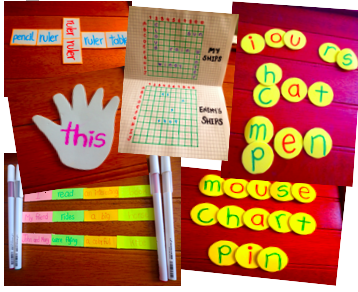12 de agosto de 2020
Supporting Children’s English Learning at Home
Angie Paola Vargas D.
One of the biggest concerns of parents who are not (usually) bilingual deals with the way to help kids when learning and reinforcing English at home. This is parents’ challenge especially when they do not master the language to support their kids’ learning, or think they are not able to do it. Although English-speaking parents give meaningful support to kids, non-speaking parents can help them as well. For Jeynes (2003), parental involvement is “the willingness of parents to participate in the education of their children” (p. 204). Moreover, “the parents’ attitudinal personality could influence their children’s second language proficiency” (Asgari & Mustapha, 2010, p. 10). Thus, parents’ participation plays a key role in their children’s learning process, whether they are bilingual or not.
Regarding students’ engagement, it is difficult for them to participate in class when they do not feel confident to do it properly. Besides being shy, they might think classmates could laugh at them if they make a mistake. In the light of this, parents can help building their kids’ confidence by practicing the language at home which is highly motivating to students as they realize that “their parents take an active interest in school because parent involvement communicates to students how important they are to their parents” (Shim, 2013, p. 20). However, “parents need to be supported in how to guide and supervise children’s language learning more effectively by teachers” (Gao, 2006, p. 296) since “the most effective aspect of parental involvement efforts lies in the interactions between parents and teachers” (Coz, as cited in Shim, 2013, p. 18). Likewise, Kaiser and Hancock (2003) declared that “teaching parents specific strategies to support their children’s development can be effective” (p. 9). Hence, this article is specially written to support to support teachers and parents who need to work together at enhancing children’s learning and promoting spaces where they feel confident to develop teaching strategies to increase learning at home.
One way to motivate students and engage them in learning activities is the performance of games and interactive activities, in which students do not feel like having an academic activity. For parents, it can be easier too because games can evoke a relaxing environment and “in order to learn and keep motivated, they (students) are determined by whether their effort or mistakes” (Torres & Vargas, 2019, par. 4). In this regard, parents can support their children’s learning by praising their effort, rather than the results so they can build self-confidence despite the fact of making mistakes. In the light of this, I compiled some meaningful ideas to guide my students’ parents on how to support learning at home; thus, with the teachers’ help, parents can have a list of vocabulary that kids are learning, or certain words that might be complex for them to use in coming activities.
Spelling: These activities can be accomplished not only with learners at different age. They can be developed either with materials we have in our homes or materials collected during a few weeks (bottle taps, for example). There should be a considerable number of them to have several letters on the top of them (vowels and consonants, at least 3). Once they are ready, parents give instructions to students to spell a word from the vocabulary list using the bottle taps; ‘hangman’ can also be played too as parents give the hints of the word to let students say the letters. For advanced students, they can play ‘Boggle’ by arranging 9 to 15 letters in a grid (vowels and consonants combined) and students have to make as many words as they can by using the letters and gain points according to the number of words made or the complexity words built.
Sight words: Using the vocabulary list from the previous idea, parents can help their kids at practicing the words by means of varied games. Firstly, parents can choose 5 words students find difficult to learn and write them in a hand-shape paper to stick on a wall. Day after day, students see and give a ‘high five’ to parents by saying one of the words. Secondly, in rectangle-shape papers (recycled paper can be used), parents write 10 words from the vocabulary list and arrange them on the floor to play ‘hopscotch’ so students step on them and have to say the word aloud (some variations can entail spelling the word, translating, giving a synonym or using it in a sentence). Thirdly, with the use of paper strips or wooden sticks, the players can set words into two to play ‘dominoes’ and every time a double piece is placed, it should be said.
The use of flashcards is another strategy to practice the language, especially because it combines several ways to enhance learning with a simple piece of paper or cardboard and some pictures that can be drawn by students. At an easy level, students can play ‘Memory game’ by matching the words (for this, two flashcards per word would be needed: one for the word and one for the picture, synonym, antonym, and description, among others, depending on the level of the student). Besides, they can be used to play ‘Charades’ by placing the card and giving a short definition or synonym; this may vary according to the level of students. ‘Bingo’ is a common game to practice as students draw a grid (e.g. 3 x 3) and write words they remember from the vocabulary list. Parents can play it by showing the picture or reading a definition of the word. It depends on the command of the language that students have when putting them into practice. Finally, a game that can be adapted is “Battleship”, consisting on choosing 5 words maximum, from 3 to 6 letters which will be placed on a 10 x 10 grid that will work as a board; when participant A gets a word from participant B’s board, participant B can say the word, while A says its meaning to get the point from the word.
Sentence construction: Sometimes, learners can handle a variety of vocabulary but they lack confidence at making sentences correctly. That is why, it is required to have some names of people (singular and plural), verbs, adjectives, nouns and time expressions (adverbs can be included considering students’ level). On the one hand, the previous words and expression can be placed on paper strips and organized in separate groups: students will build the sentence by choosing one strip from each group to make a chain with the words (e.g. I read an interesting book). These can be taken from the textbook or given by the teacher so parents can assess the sentence. On the other hand, this activity can also be done by using popsicle sticks and following the same process and classifying the words with colors so it grabs the learner’s attention.
Productive skills: Once students have acquired vocabulary and are more confident at organizing words, they can step on the productive skills: speaking and writing, by doing the following activities. Firstly, this activity requires parents’ time on selecting pictures that are easy to understand and can have slight differences, or they can be drawn by participants. One way is to show the picture to students and elicit from them a description from them, by mentioning what objects can be seen, what actions are developed, where the picture is portrayed; students can label the image with short sentences on post-its or to say them aloud if they feel more confident. Another way is to find the differences in two pictures. Students do not need to have the same picture. A condition in this activity is to have different pictures so students can describe them.
These strategies require time and engagement from both teachers and parents to support students in their process as teachers know the strategies and parents can make the student feels at ease by praising his or her effort and acknowledging that confidence is built once students go on practicing.
___________________
References
Asgari, A., & Mustapha, G. (2010). The Influence of Informal Language Learning Environment (Parents and Home Environment) on the Vocabulary Learning Strategies. English Language and Literature Studies , 1 (1), 7-13.
Gao, X. (2006). Strategies used by Chinese parents to support English language learning: Voices of ‘Elite’ unviersity students. Regional Language Centre Journal , 37 (3), 285-298.
Jeynes, W. (2003). A meta-analysis: The effects of parental involvement on minority children’s academic achievement. Education and Urban Society. 35(2), 202-2018.
Kaiser, A., & Hancock, T. (2003). Teaching parents new skills to support their young children’s development. Infants and Young Children , 16 (1), 9-21.
Shim, J. (2013). Involving the parents of English language learners in a rural area: Focus on the dynamics of teacher-parent interactions. National Rural Education Association , 34 (3), 18-26.
Torres, A., & Vargas, A. (2019, October 26). Universidad Externado de Colombia. Retrieved July 3rd, 2020 from Cuestiones Educativas: https://cuestioneseducativas.uexternado.edu.co/how-to-keep-children-motivated-in-an-overwhelming-world/


